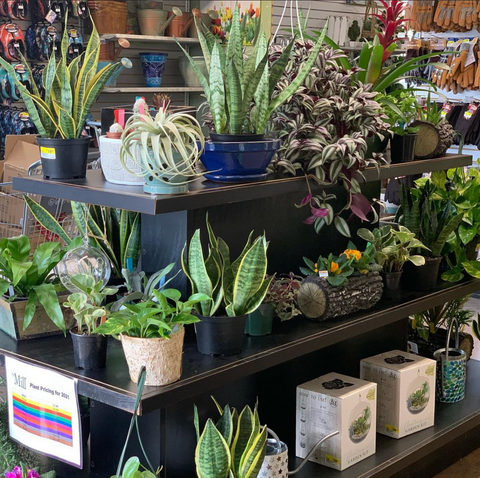Many people not only enjoy plants outside but include them in their indoor décor. Plants remove toxins in our air such as formaldehyde, benzine, xylene, and ammonia. These are all by-products of cleaning solutions, plastics, synthetic materials, aerosol sprays, varnishes, paints, and other products. Plants are all engineered to take in atmospheric carbon dioxide and with light and water convert it to sugars for feed. The by-product of this process is oxygen which we require to live and remain healthy. Most plants release 10 times more oxygen during the day than they consume at night. During cold weather, the air quality in our closed-up homes becomes more polluted with these damaging toxins.

Detoxifying your air is something all plants indoor and out do as they breathe. NASA recommends that having two or three 8-inch plants per 100 square feet inside your residence will help keep your air safer based on their experiments with enclosed shuttles for extended time periods.
Houseplants are just like outdoor plants and each can handle situations better than others. All plants produce oxygen, and the larger-leaved plants will produce more but they often are harder to maintain. If you are worried about your pets having adverse reactions to plants, we would suggest you review the ASPCA Houseplant Recommendations. There is a comprehensive list of almost all houseplants and their side effects, but keep in mind the amount that they must consume in many cases is not something they would do.

So, which ones are best for your house?
If you have a sunny, warm location try:
Aloe |
Jade |
Euphorbia trigona or Milk Tree |
Sago Palm |
Papyrus |
Croton |
Ponytail Palm |
All of these can handle warm dryer air and sun with little care
In the shaded room that is cooler try:
Dracaena |
Aspidistra |
Jade |
Kentia Palm |
Rhaphis excelsa or Lady Palm |
Sansevieria or Snake Plant |
For fragrance either from flower or foliage try:
Jasmine |
Mint |
Eucalyptus |
Gardenia |
Rosemary |
In the humid bathroom with good light try:
Ferns |
Tillandsia |
Bromeliads |
Orchids |
For hanging pots and or cascading plants try:
Pothos |
Philodendron |
Peperomia |
Senecio |
Chlorophytum |
Tradescantia |
For an indoor plant that flowers try:
Orchids |
African Violets |
Begonias |
Kalanchoe |
Cyclamen |
Jasmine |
Gardenia |
Gerbera |
Chrysanthemum |
In bedrooms try:
Pothos |
Dracaena |
Sansevieria |
Aloe |
One other interesting point is that there are around 7% of plants that breathe using the Crassulacean Acid Metabolism or CAM meaning they remove CO2 at night and therefore release more oxygen at night. These are best placed in your bedroom for higher oxygen levels during evening hours. These plants are mainly all epiphytes which are plants that live in arid conditions using other plants for support and derive nutrition from air and moisture. These all have the capability of storing water in their roots, leaves, and tissues and include:
Bromeliads |
most Orchids |
Tillandsia |
Air Plants |
many Ferns |
Mosses |
Agave |
Aloe |
many Cacti |
Match plant with location as all of the plants listed above have specific preferences to thrive.
There are many plants that can assist with cleansing the air in your residence. Growing fresh herbs in or close to your kitchen is beneficial as well as having Poinsettias, Christmas Cactus,and forced bulbs for the holiday season. Terrariums are another way to display tiny houseplants and are especially fun for children as they can observe how the plants grow. Read more about terrariums here.
Terrariums are making a comeback as you can start small and if the plants outgrow the terrarium or become overbearing you can re-pot into larger containers. This way you are growing your own houseplants. Some houseplants are passed from generation to generation like African Violets. I still have my grandmother’s plant or at least a plant that came from hers. Taking cuttings and rooting them to share with friends and family is fun and offers you the ability to grow something during the off months.
Have fun and keep enough houseplants to keep your home healthy.
By Cindy King, Certified Professional Horticulturist (CPH), The Mill













